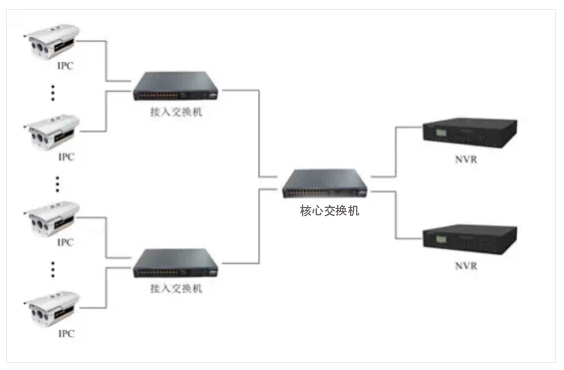Many friends have asked whether a core switch is needed for a 100-channel surveillance system. When it comes to core switches, one inevitably thinks of the networking methods of switches. How do different-sized networks get structured?
There are three common networking methods for surveillance projects, let’s take a look.
Architecture 1: Small Projects with Around 10 Points
For small projects with 50 points, a standard 100Mbps switch can be used to establish the network environment. If we use a 2-megapixel IPC with a bitrate of 4Mbps, the bandwidth occupied by 10 cameras would be 10*4=40M. The actual usage of a 100Mbps switch is 50%-70%, which is 50-70M, fully capable of meeting the transmission requirements of 8 IPCs.

We can see that the topology diagram of a small network does not use a core switch.
Architecture 2: Medium-Small Projects with 50-100 Points
For medium-small projects with 50-100 points, simply using a 100Mbps switch is far from sufficient. A higher-performance full-gigabit switch is needed as a core switch to ensure smooth transmission of video information.
For example, if we use a 2-megapixel IPC with a bitrate of 4Mbps, the bandwidth occupied by 100 cameras would be 4M*100=400M. If we connect 10 cameras to a 100Mbps switch, we would need 10 access layer switches, and the core layer switch would require three full-gigabit switches.
The framework diagram is as follows:

For a network with 100 points, generally only the core switch and access layer switches are used, without the need for aggregation layer switches.
Architecture 3: Medium-Large Projects with Over 100 Points
For medium-large projects with over 100 points, a three-layer network architecture is required: access layer, aggregation layer, and core layer. Due to the larger number of points, the performance requirements for the core layer switch are high. In such cases, it is generally necessary to choose a three-layer full-gigabit core switch from well-known manufacturers like Huawei or H3C. Large network setups will always use a three-layer network structure. This has also been a question raised by friends in our weak current VIP group, whether 200 surveillance points require an aggregation switch? The answer is yes; without an aggregation layer switch as a medium, the core switch will be under significant pressure, leading to network congestion and delays. Choosing the right networking method based on project conditions is beneficial for equipment selection, and a reasonable network structure can help avoid some failures.
Large network setups will always use a three-layer network structure. This has also been a question raised by friends in our weak current VIP group, whether 200 surveillance points require an aggregation switch? The answer is yes; without an aggregation layer switch as a medium, the core switch will be under significant pressure, leading to network congestion and delays. Choosing the right networking method based on project conditions is beneficial for equipment selection, and a reasonable network structure can help avoid some failures.
Latest weak current data update—Complete construction quotes for weak current surveillance systems (September 18)